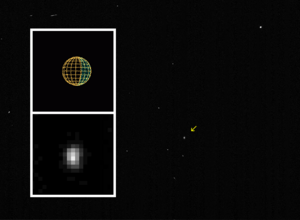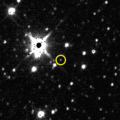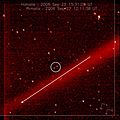Himalia (moon) facts for kids

Himalia as seen by Cassini-Huygens
|
|
| Discovery | |
|---|---|
| Discovered by | C. D. Perrine |
| Discovery date | December 3, 1904 |
| Orbital characteristics | |
| Periapsis | 9,782,900 km |
| Apoapsis | 13,082,000 km |
|
Mean orbit radius
|
11,460,000 km |
| Eccentricity | 0.16 |
| 250.56 d (0.704 a) | |
|
Average orbital speed
|
3.312 km/s |
| Inclination | 27.50° (to the ecliptic) 29.59° (to Jupiter's equator) |
| Satellite of | Jupiter |
| Physical characteristics | |
|
Mean radius
|
85 km |
| ~90,800 km² | |
| Volume | ~2,570,000 km³ |
| Mass | 6.7×1018 kg |
|
Mean density
|
2.6 g/cm³ (assumed) |
| ~0.062 m/s2 (0.006 g) | |
| ~0.100 km/s | |
|
Sidereal rotation period
|
7.782 h |
| Albedo | 0.04 |
| Temperature | ~124 K |
Himalia is the largest moon of Jupiter that is not perfectly round. It was discovered by Charles Dillon Perrine at the Lick Observatory on December 3, 1904. This moon is named after Himalia, a nymph (a nature spirit in Greek myths). She had three sons with Zeus, who is the Greek god equivalent to the Roman god Jupiter.
Contents
What's in a Name?
Himalia did not always have its current name. Until 1975, it was simply called Jupiter VI or Jupiter Satellite VI. This meant it was the sixth moon discovered around Jupiter.
However, scientists thought that using numbers for moons could get confusing. It was like how Saturn's moons used to be numbered. Giving moons proper names felt more poetic and easier to remember.
For a short time, from 1955 to 1975, the moon was sometimes called Hestia. This name came from the Greek goddess of the hearth.
Himalia's Orbit
Himalia is the biggest member of a group of moons known as the Himalia group. All the moons in this group share similar paths around Jupiter. They orbit between 11.4 and 13 million kilometers from Jupiter.
Their orbits are tilted by about 27.5 degrees compared to Jupiter's equator. The paths of these moons can change a lot. This is because of the strong gravity from the Sun and Jupiter itself.
Physical Features
A day on Himalia is very short, lasting only about 7 hours and 45 minutes. Himalia looks grey, just like the other moons in its group. It is similar in color to a C-type asteroid, which is a common type of space rock.
The Cassini spacecraft studied Himalia. It found that the moon's surface does not have many distinct features. There was a small sign of water on its surface.
Exploring Himalia
Spacecraft have taken pictures of Himalia as they traveled through space.
In November 2000, the Cassini spacecraft flew past Himalia. Cassini was on its way to Saturn. It took several pictures of Himalia from about 4.4 million kilometers away. Even from that distance, the photos showed Himalia is not perfectly round. It looked like a stretched object, about 150 km long and 120 km wide. These measurements were close to what scientists on Earth had estimated.
Later, in February and March 2007, the New Horizons spacecraft also took pictures of Himalia. New Horizons was on its way to Pluto. It captured images from about eight million kilometers away. In these photos, Himalia still appeared as only a few pixels.
Images for kids
-
Himalia's rotational light curve from Earth-based observations taken between August and October 2010.
See also
 In Spanish: Himalia (satélite) para niños
In Spanish: Himalia (satélite) para niños







